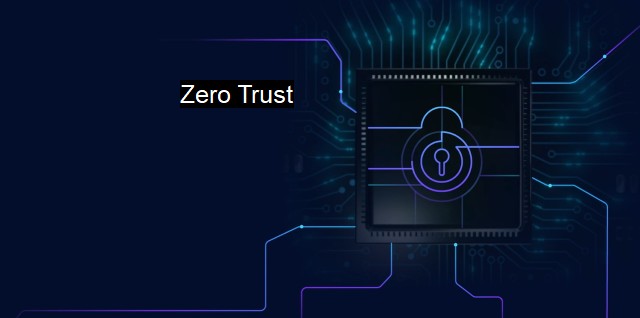What is Zero Trust?
Zero Trust: Advancing Cybersecurity in the Era of Growing Cyber Threats
Zero Trust is a robust cybersecurity strategy used by organizations to prevent data breaches. The concept fundamentally operates on the premise of having no trust in any entity outside or within their network. Hence, the term "Zero Trust". This principle implies that every user, device, or server, located either on-premises or off-premises, must undergo proper verification procedures before given access to any applications or resources in the corporate network.The Zero Trust strategy has gained considerable momentum in the cybersecurity industry mainly due to the drastic increase in cybersecurity threats and breaches. Earlier network security policies often revolved around maintaining peripheries and relied heavily on firewalls and VPNs to secure networks. On the other hand, The Zero Trust model eliminates the traditional concepts of networks and perimeters, enforcing strict identity verification for each and every user or device trying to access network resources, irrespective of their location.
The Zero Trust framework operates by segregating the network into microperimeters or "microsegments." Each of these microsegments, which consist of vital data or application resources, is encased in multiple stringent layers of security. Users or devices are granted minimum access to these micro-segments in the network, always adhering to the "least privilege access" policy. Therefore, even if a threat actor manages to infiltrate a part of the network, their access would be confined to that only micro-segment, thereby limiting any potential damage.
The Zero Trust model also emphasizes deploying advanced user verification techniques such as Multi-Factor Authentication (MFA) and stringent security policies. MFA includes validating the user with multiple evidences like something they have (like a smart card or token), something they are (like a biometric feature), or something they know (like a password or PIN). Therefore, the Zero Trust approach not just denies unauthorized entries but also ensures permitted users are not granted more access than what they need.
The rise in cloud technologies and remote working environments has also necessitated adopting the Zero Trust model in cybersecurity strategies. Traditional antivirus and firewall solutions often fall short and are not adequate to secure these complex networks and data mobility. Looking at the rapid growth of sophisticated cyber threats and data breaches, along with increasing regulatory requirements and sanctions, secure access has become more Paramount than ever.
Considering the point in hand, the Zero Trust model proves to be more effective than conventional methods. it is also essential to address that implementing Zero Trust is more than just a technology deployment. It requires a cultural shift in the organization—a change in how all parties involved view security. It is not an "all-or-none" approach but revolves more around risk management.
Zero Trust operates centrally on sophisticated technologies like Artificial Intelligence (AI) and Machine Learning (ML) for enforcing strict access policies and network segregation. These technologies help in evidencing abnormal traffic and activity patterns in real-time, thereby stopping threats right in their tracks. Over time, as new tools and technologies begot further threats, Zero Trust may likely evolve to develop more diverse and in-depth defenses.
Zero Trust is an advanced methodology in the field of cybersecurity that ensures better data protection. It safeguards important data and network resources better by not trusting any user or device, keeping in line with the dictum "never trust, always verify". The growing adoption of the model by both large-scale industries and smaller enterprises indicate that Zero Trust is key to shaping the future of cybersecurity.

Zero Trust FAQs
What is zero trust?
Zero trust is a cybersecurity approach that assumes that all users, devices, and applications are untrusted by default. It prioritizes security over convenience and requires verification and authentication of every user and device attempting to access resources, regardless of their location.How does zero trust improve cybersecurity?
Zero trust helps improve cybersecurity by implementing strict access controls and limiting the amount of access granted to users and devices. It can prevent lateral movement and the spread of malware and other cyber threats by segmenting the network and ensuring that only authorized users and devices can access specific resources.What are the benefits of implementing a zero trust approach?
The benefits of implementing a zero trust approach include improved security posture, reduced risk of data breaches, better protection of sensitive data, and increased visibility and control over network activity. It can also help organizations comply with various regulatory requirements and standards.Is zero trust the same as antivirus protection?
No, zero trust is not the same as antivirus protection. Antivirus protection is a software that helps detect and remove malicious software from a device, while zero trust is a cybersecurity approach that focuses on access control and verification of every user and device attempting to access resources. While antivirus protection can be a part of a zero trust approach, it is not the only element necessary to implement the zero trust model.| | A | | | B | | | C | | | D | | | E | | | F | | | G | | | H | | | I | | | J | | | K | | | L | | | M | |
| | N | | | O | | | P | | | Q | | | R | | | S | | | T | | | U | | | V | | | W | | | X | | | Y | | | Z | |
| | 1 | | | 2 | | | 3 | | | 4 | | | 7 | | | 8 | | |||||||